Polar bears and grizzly bears are distinguished by their habitats, diets, and physical features.
Polar bears are bigger, white-furred, and adapted for Arctic life, feeding primarily on seals. Grizzly bears, smaller with brown fur, inhabit North American forests and plains, consuming a varied diet including berries, roots, fish, and mammals.
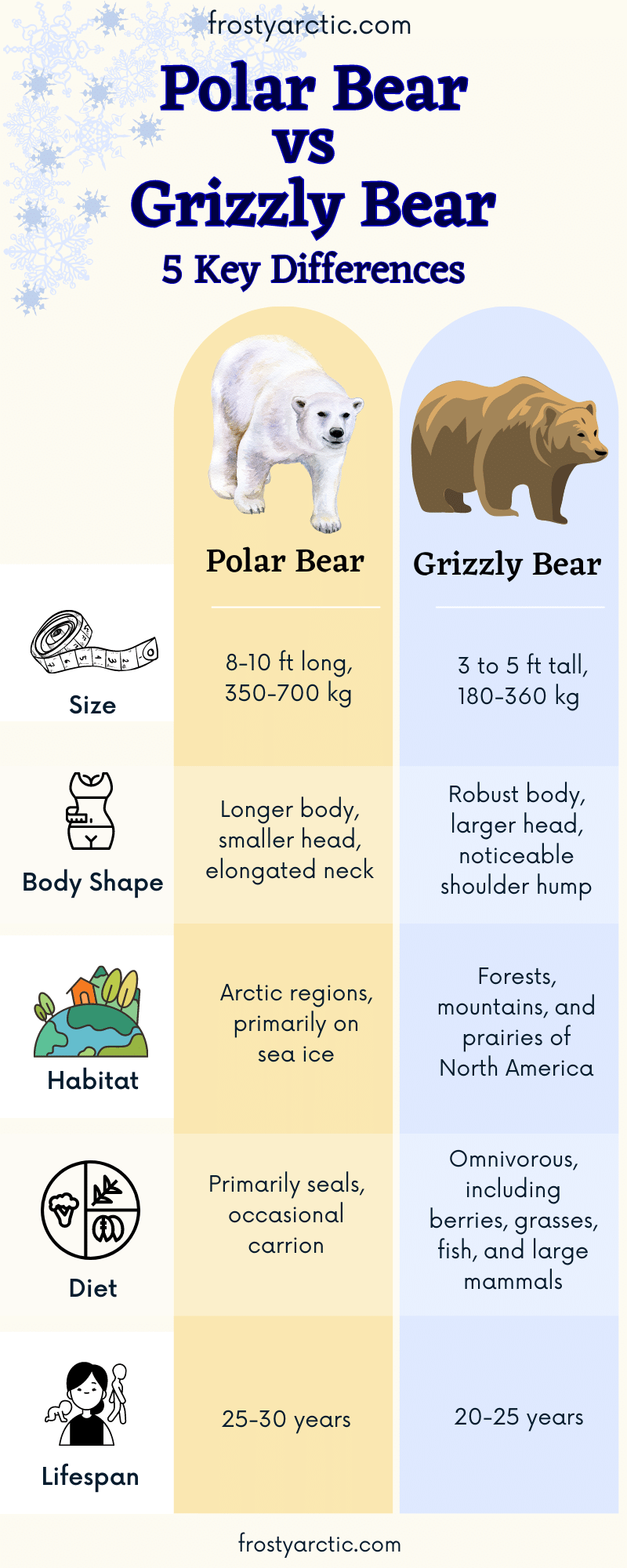
Living under harsh and contrasting conditions, both of these bears have adopted distinctive traits and lifestyles that make them true masters of their environments.
Ready to dive deep into the details? Keep reading! Our adventure will reveal surprising differences, highlighting how each bear species has uniquely adapted to thrive in its environment. Let’s explore the world of these magnificent bears to unearth their captivating stories.
Polar Bear vs Grizzly Bear: A Quick Comparison
| Feature | Polar Bear | Grizzly Bear |
| Scientific Name | Ursus maritimus | Ursus arctos horribilis |
| Body Shape | Longer body, smaller head, elongated neck | Robust body, larger head, noticeable shoulder hump |
| Size | 8-10 ft long, 350-700 kg | 180-360 kg, 3 to 5 ft tall |
| Diet | Primarily seals, occasional carrion | Omnivorous, including berries, grasses, fish, and large mammals |
| Habitat | Arctic regions, primarily on sea ice | Forests, mountains, and prairies of North America |
| Social Behavior | Generally solitary, non-territorial, social around plentiful food | Generally solitary, can aggregate at plentiful food sources, protective mothers |
| Lifespan | 25-30 years | 20-25 years |
| Gestation Period | 195-265 days | 180-250 days |
| Defense Mechanisms | Powerful swimmers; can use their front paws for striking | Extremely powerful, can stand on hind legs, uses front claws |
| Interaction With Humans | Less frequent can be dangerous when food is scarce | More frequent due to habitat overlap, can be aggressive if surprised or threatened |
| Threats | Climate change (loss of sea ice), pollution, increased human activity | Habitat loss, human conflict, road mortality, reduced food availability |
| IUCN Status | Vulnerable | Least Concern (varies by population) |
| Other names | white bear, sea bear, ice bear, great white northern bear | North American brown bear or grizzly |
What Are the Key Differences?
Polar bears and grizzly bears, tied together by their shared lineage within the same family, are remarkable creatures shaped by their unique environments. Both bears primarily feed on a protein-rich diet and are formidable predators.
However, despite these shared traits, polar bears and grizzly bears possess many differences that are as diverse as their habitats. So, let’s discover these differences.
1. Taxonomy and Scientific Classification
Polar bears and grizzly bears are both members of the Ursidae family, also known as the bear family. However, they belong to different species and subspecies within this family.
Polar bear
The polar bear is scientifically known as Ursus maritimus, meaning “maritime bear.” It is classified as a distinct species in the genus Ursus within the family Ursidae.
Scientifically, polar bears are closely related to brown bears. Interestingly, genetic studies reveal that the polar bear is a relatively new species, having diverged from brown bears approximately 500,000 to 600,000 years ago.
Grizzly bear
On the other hand, the grizzly bear is a subspecies of the brown bear, Ursus arctos. Its scientific name is Ursus arctos horribilis.
The term “grizzly” refers to the “grizzled” appearance of their fur, which has lighter tips on a darker base, giving the bears a somewhat golden appearance. ~Source
| Taxonomic Rank | Polar Bear | Grizzly bear |
| Kingdom | Animalia | Animalia |
| Phylum | Chordata | Chordata |
| Class | Mammalia | Mammalia |
| Order | Carnivora | Carnivora |
| Family | Ursidae | Ursidae |
| Genus | Ursus | Ursus |
| Species | U. maritimus | U. arctos horribilis |
2. Habitat and Distribution
These closely related species live in very different habitats that are well-suited to their different lifestyles and dietary needs.
Polar Bear
Polar bears are primarily associated with the Arctic, which is characterized by icy seas, ice floes, and tundra. They have a circumpolar distribution and are found in
- Canada
- Alaska (USA)
- Greenland
- Russia
- Norway(Svalbard).
A less dense population is also found on the sea ice off the east coast of Greenland and the northern islands of the Norwegian archipelago.
Grizzly Bear
Grizzly bears, in contrast, are found across a much broader range of environments. While once widespread across much of North America, Europe, and Asia, their current North American range includes
- Parts of Alaska
- Western Canada
- Isolated areas in the northwestern United States, such as Yellowstone and Grand Teton National Parks.
Grizzly bears are highly adaptable and can be found in a variety of habitats, including
- Forests
- Alpine meadows
- Prairies
- Arctic tundra,
- Semi-desert areas.
They are usually associated with dense forests but are also found in open plains and alpine regions.
| Characteristic | Polar Bear | Grizzly Bear |
| Habitat | Primarily sea ice | Forests, alpine meadows, prairies, tundra, and even semi-desert areas |
| Distribution | Circumpolar: Canada, Russia, Greenland, U.S. (Alaska), and Norway (Svalbard) | North America: Alaska, western Canada, and isolated areas in the northwestern U.S. |
| Reliance on environment | Highly dependent on sea ice for hunting | Adaptable to a variety of environments |
3. Physical Appearance
While both are members of the bear family, these bears are distinguished by several physical characteristics.
Polar Bear
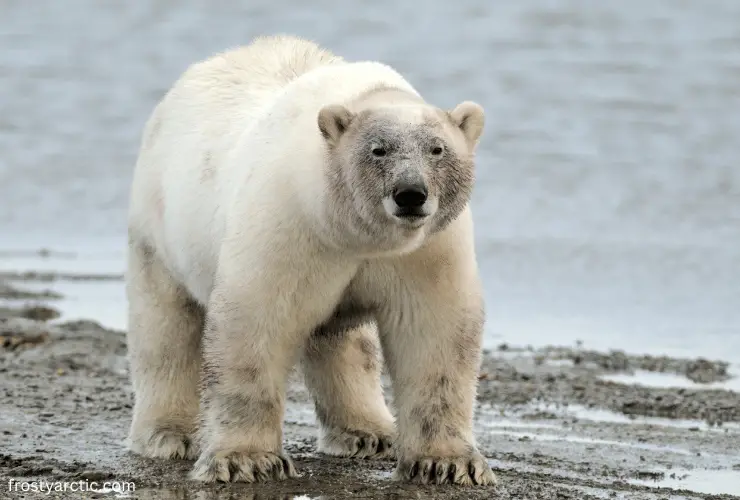
- Size and Weight: Polar bears are the largest land carnivores, with males often weighing between 350 and 700 kg and measuring up to 3 m in length. Females are typically half the size of males.
- Coat: They are characterized by a distinctive white or yellowish-white coat that provides camouflage in the snow and ice.
- Body Shape: Polar bear’s most defining trait is its more elongated body shape.
- Facial features: They have a longer skull and nose compared to other bear species, which aids them in searching for seals in deep holes and crevices in the ice. Their small ears and tail help to conserve heat.
- Paws: Their large and wide paws are also well-suited for swimming and walking on ice, as detailed by the Alaska Department of Fish and Game.
Grizzly Bear
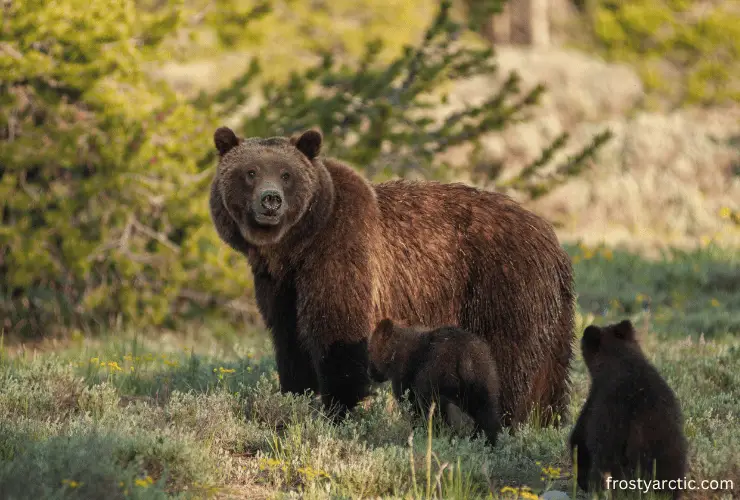
- Size and Weight: Grizzly bears, on the other hand, are smaller than polar bears. Adult males typically weigh between 180 and 360 kg, and females are usually around half the size of males.
- Coat: The grizzly bear’s fur ranges from dark brown to light tan and often appears “grizzled” or silver-tipped.
- Body Shape: Unlike the polar bear’s long and slender body, the grizzly bear is more robust and muscular, adapted for a diverse diet and rugged terrains. They are notable for their distinctive hump on their shoulders.
- Facial features: They have a concave face shape, smaller and rounder ears, and a large nose.
- Paws: They have compact and powerful paws that are built for digging and running.
| Feature | Polar Bear | Grizzly Bear |
| Size (Males) | 350-700 kg, up to 3 m in length | 180-360 kg |
| Coat | White or yellowish white | Dark brown to light tan, often appears “grizzled” or silver-tipped |
| Body Shape | Elongated body, longer skull and nose | Robust and muscular, noticeable hump on shoulders |
| Paws | Large and wide, adapted for swimming and walking on ice | Compact and powerful, built for digging and running |
| Ears | Rounded and small to conserve heat | Smaller and rounder than most bear species |
| Nose | Long and slender | Large and robust |
4. Diet and Feeding Habits
These bears also have unique diets and feeding habits.
Polar Bear
Polar bears are classified as hypercarnivores, meaning their diet is more than 70% meat. They are specialized seal hunters, with ringed and bearded seals as their primary prey.
These marine mammals hunt primarily on the sea ice, using a “still hunting” technique where they wait beside seals breathing holes in the ice. When a seal surfaces to breathe, the polar bear uses its power and strong claws to pull the seal out of the water.
During summer, when sea ice is minimal, this white bear of Arctic regions may also consume other food items such as birds, eggs, vegetation, rodents, shellfish, crabs, and carcasses. However, these are generally minor components of their diet.
Grizzly Bear
Grizzly bears, in contrast, have an omnivorous diet, meaning they feed on both plants and animals. They are highly adaptable feeders with a diet that can vary widely depending on the season and their specific habitat. Their meals can include
- Berries
- Roots
- Grasses
- Fish
- Rodents,
- Large mammals, such as elk and moose.
Notably, grizzly bears in coastal regions, especially in Alaska and Canada, have a diet heavily supplemented by salmon during summer. This abundant, high-fat food source helps them accumulate fat reserves for winter hibernation.
| Aspect | Polar Bear | Grizzly Bear |
| Diet Type | Hyper carnivorous | Omnivorous |
| Primary Prey | Seals (especially ringed seals and bearded seals) | Varies widely, including berries, roots, grasses, fish, rodents, and large mammals |
| Hunting Technique | Still hunting on sea ice | Opportunistic feeding with foraging, fishing, and hunting |
| Seasonal Variations | Diet changes slightly during summer, includes birds, eggs, vegetation, and carcasses | Diet changes with season and availability of food sources, e.g., heavy salmon consumption in summer |
5. Social Behavior
Both these bears exhibit unique social behaviors that are adapted to their respective environments.
Polar Bear
Polar bears are generally solitary animals, with adult bears typically seen alone except during the breeding season. However, they aren’t territorial and have been observed to tolerate each other in places where food is abundant, like a whale carcass.
Mothers and cubs are often seen to be more social, with the cubs play-fighting to learn important survival skills. ~Source
Grizzly Bear
Like polar bears, grizzly bears are generally solitary, with the most common social group being a mother and her cubs. Adult males and non-pregnant females can, however, be seen together during the mating season.
While they are not typically territorial, grizzly bears can exhibit aggressive behavior when competing for food or mates or when a mother is protecting her cubs.
Interestingly, grizzly bears can form large aggregations in places with ample food sources, such as salmon spawning sites. ~Source
| Characteristic | Polar Bear | Grizzly Bear |
| Social Structure | Solitary, except during mating season and between mothers-cubs | Solitary, except during mating season, between mothers-cubs, and at abundant food sources |
| Territorial Behavior | Generally, not territorial | Can show aggression when competing for food or mates |
6. Reproduction and Lifecycle
Reproduction and lifestyle habits in polar bears and grizzly bears, while having some similarities, also exhibit key differences.
Polar Bear
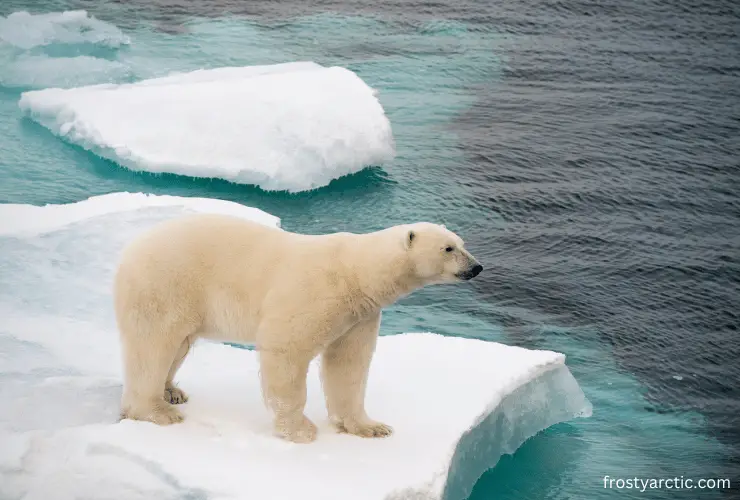
Polar bears mate between March through May. After mating, the fertilized eggs undergo delayed implantation, where they begin to develop in September or October.
The female polar bear, or sow, will enter a den in the late autumn, where she gives birth to one to three cubs (usually two) during the winter, often around December.
The cubs, born blind and helpless, will stay in the den until March or early April, when they have grown enough to accompany their mother onto the sea ice. The cubs stay with their mother for over 2 years before setting off independently.
Polar bears can live around 25-30 years in the wild. But only a few reach old age due to the harsh conditions in their environment.
Grizzly Bear
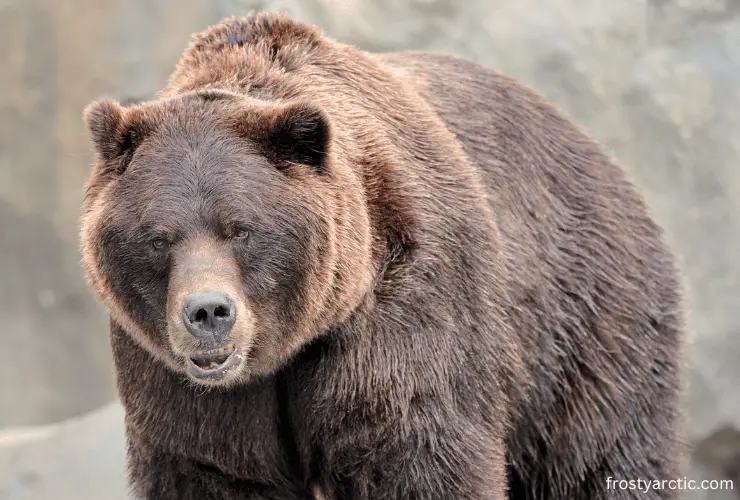
Grizzly bears mate between May and July, with the fertilized eggs also undergoing delayed implantation until the mother bear enters her den in the fall.
The sow gives birth to one to four cubs (commonly two) during the winter while she is still hibernating, usually in January or February.
Grizzly bear cubs are also born blind and helpless but begin to venture outside the den with their mother as early as February or March. The cubs stay with their mother for about 2 to 3 years before venturing independently.
Grizzly bears can live around 20 to 25 years in the wild, as documented in an article published in PLoS ONE.
| Characteristic | Polar Bear | Grizzly Bear |
| Lifestyle | Solitary, life closely tied to sea ice | Mostly solitary, but can congregate in areas with abundant food |
| Mating Season | April to June | May to July |
| Delayed Implantation | Yes | Yes |
| Denning Period | Late autumn to March/April | Fall to February/March |
| Cubs at Birth | One to three (usually two), born blind and helpless | One to four (commonly two), born blind and helpless |
| Cub Dependency Period | Over two years | Approximately two to three years |
| Lifespan | 25-30 years in the wild | 20-25 years in the wild |
7. Natural Predators
Polar bears and grizzly bears are apex predators, meaning they sit at the top of the food chain in their particular ecosystems. However, young and weak individuals do face some threats.
Polar Bear
Young polar bears, especially cubs, are more vulnerable and can fall prey to other carnivores, including other polar bears. This can occur particularly during times when food is scarce.
Additionally, cubs can be threatened by Arctic foxes and wolves if left unprotected, as detailed in a report by COSEWIC.
Grizzly Bear
Like polar bears, cubs and young grizzly bears are at risk from various predators, including wolves, mountain lions, cougars, and other bears, if they stray too far from their mothers.
| Species | Predators |
| Polar bear cubs | Vulnerable to other polar bears (cannibalism), Arctic foxes, and wolves |
| Grizzly cubs | Threatened by wolves, mountain lions, cougars, and other bears |
8. Defense Mechanism
Polar bears and grizzly bears are equipped with various defensive mechanisms that allow them to ward off threats and protect themselves and their offspring in their respective habitats.
Polar Bear

Polar bears rely primarily on their size and strength for defense. They are equipped with powerful forelimbs capable of killing with a single swipe and sharp claws for gripping and holding tightly. Their teeth are sharp and strong, designed to bite through flesh.
Apart from their physical strength, polar bears often stand on their hind legs to appear even larger when they perceive a threat. They might charge or roar to intimidate the intruder if the threat persists.
However, polar bears are generally more likely to flee than fight, unless they are defending their cubs or a food source.
Grizzly Bear
Grizzly bears also have a formidable size and strength, which serve as their primary defense. Their muscle hump provides power to the forelimbs, making their swipes incredibly strong.

They have long, sharp claws (up to four inches long) and a powerful bite force capable of crushing bones.
Behaviorally, when threatened, a grizzly bear will often stand on its hind legs to assess the situation and appear larger. They may perform “mock charges,” rushing forward but stopping short of contact, or make loud noises by huffing, jaw popping, and growling to intimidate potential threats.
Grizzly mothers, or sows, are particularly defensive and aggressive when protecting their cubs. ~Source
| Characteristic | Polar Bear | Grizzly Bear |
| Physical Defenses | Powerful forelimbs, sharp claws, and strong teeth | Powerful muscle hump, long and sharp claws, strong bite force |
| Behavioral Defenses | Standing on hind legs to appear larger, fleeing, charging, and roaring | Standing on hind legs to appear larger, mock charging, huffing, jaw popping, growling |
| Protection of Young | Will fight to protect cubs | Highly defensive and aggressive when cubs are threatened |
9. Interaction With Humans
Each species also has unique patterns of behavior in response to human presence.
Polar Bear
Since polar bears are found in remote, sparsely populated regions, encounters with humans are generally less frequent than with grizzly bears.
However, due to the loss of sea ice, these bears spend more time on land, where they are likely to encounter humans more often.
They are curious animals and might approach human settlements or camps searching for food, especially when their primary food source is scarce. This can lead to conflicting situations, and although attacks on humans are rare, they can be deadly.
Grizzly Bear
Grizzly bears have a broader range of habitats, many of which overlap with human activities, leading to more frequent encounters. These bears are known to be very protective of their food sources, and accidental surprises or close encounters can lead to attacks.
However, these bears normally tend to avoid humans. When they do encounter people, they often choose to retreat unless they feel threatened or provoked.
Like polar bears, grizzly bears can be attracted to human food sources, leading to conflicts in campgrounds and residential areas.
| Characteristic | Polar Bear | Grizzly Bear |
| Frequency of Human Encounters | Less frequent, but increasing due to climate change | More frequent due to habitat overlap |
| Common Causes of Conflict | Searching for food, especially when seal populations are low | Protection of cubs or food sources, attraction to human food |
| Attacks on Humans | Rare but can be deadly | Can occur when bears are surprised or feel threatened |
| Conflict Prevention Measures | Polar bear patrols, bear-proof food storage, aversive conditioning | Safe viewing practices, proper food storage, bear spray, noise-making |
10. Threats and Conservation Status
Though much safer from natural predators, these gigantic bears face numerous threats from human activities.
Polar Bear
Polar bears are listed as ‘Vulnerable’ by the IUCN. The biggest threat to polar bears is the loss of sea ice due to climate change, as described by the World Wildlife Fund.
Other threats include
- Pollution with chemicals and oil spills
- Risen human activity, including shipping and resource exploration
Grizzly Bear
The grizzly bear is listed as ‘Least Concern’ by the IUCN, though this does not mean all populations are thriving. In some areas, especially in the contiguous U.S., grizzly bears are threatened and protected under the Endangered Species Act. ~Source
Threats to grizzly bears include
- Habitat loss and fragmentation caused by human development
- Road mortality
- Illegal hunting
| Characteristic | Polar Bear | Grizzly Bear |
| IUCN Status | Vulnerable | Least Concern (varies by population) |
| Primary Threats | Loss of sea ice habitat, pollution; increased human activity in the Arctic | Habitat loss and fragmentation, road mortality, illegal hunting |
11. Polar Bear vs. Grizzly Bear: Who Would Win a Fight
Polar bears and grizzly bears are both powerful creatures, but they have different strengths.
Polar bears are bigger than grizzly bears. They have a stronger bite force, around 1200 psi, compared to the grizzly’s 975 psi. This means polar bears can bite harder. Polar bears also have larger paws, which help them move in the snow and swim to catch prey.
However, grizzly bears have their own advantages. They have longer claws, more adapted for swiping, which can cause damage to opponents. Grizzly bears also have robust skulls that can withstand impacts, while polar bears have slender skulls that make them vulnerable to head injuries.
Interestingly, a 2015 study found that grizzly bears were dominant when competing with larger polar bears for a beached whale carcass.
Grizzly bears can run faster, reaching up to 35 miles per hour. The grizzly bear would likely win if a fight turned into a chase. But if it were a swimming race, the polar bear would have the advantage due to its larger paws.
In terms of intelligence, polar bears are considered one of the world’s most intelligent hunters. They can stalk prey over long distances and outsmart them.
So, who would win in a fight? It depends on the situation. If it was a close fight, the polar bear’s size and strength might give it the edge. But if there was distance involved, the grizzly bear’s speed could make it the winner.
Wrapping Up
So, are polar bears and grizzly bears the same? Certainly not! While they share one family, each has carved a unique path in the wild, brilliantly adapting to their distinct environments.
Grizzly bears are technically a subspecies of the larger group of brown bears. Contrarily, polar bears are a separate species altogether. Polar bears are specialists acclimated to the intense Arctic environment. Grizzly bears are more generalists, able to adapt to a wider range of habitats and food sources.
We hope this blog has enhanced your knowledge and admiration of our world’s glorious biodiversity. Don’t hesitate to dive back in for more informative comparisons!

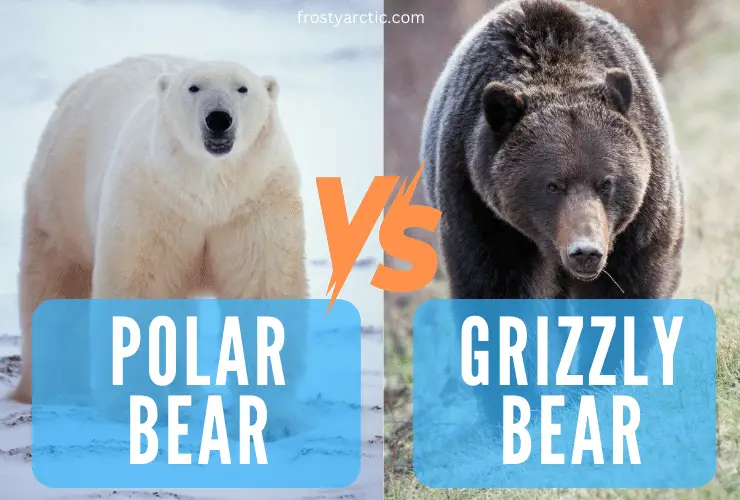

4 thoughts on “Polar Bear vs Grizzly Bear: Key Differences & Battle Winner”